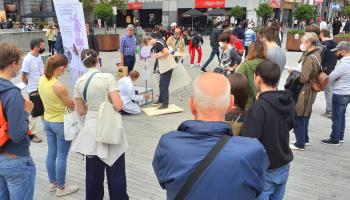No more PASTA for Italian astronaut Samantha Cristoforetti, who will be the eighth astronaut to manipulate the Soft Matter Dynamics Container (SMD) and replace the PASTA experiment cells with those from FOAM-C.
The 15th edition of the exhibition Science & Culture at the Palace will be presented by the Belgian Science Policy (BELSPO) from July 23 until August 28. After a two-year absence, it is finally time again to discover the 10 federal scientific research and cultural institutions in the Grand Gallery of the Royal Palace itself ! Entitled "Ensuring the Future", this year's expo will showcase a work of art, an artifact, a scientific instrument or a model that symbolises the objectives of these institutions to strive for a better tomorrow. Mandatory registration !
On July 19 & 20, space lovers can fill their hearts and heads with planets, meteors, space weather and astronautics at this year's edition of Astropolis Space Village, in Ostend, Flanders. Free entrance !
A few years ago the European Space Agency’s Rosetta spacecraft visited comet 67P Churyumov-Gerasimenko (2014-2016). You may remember the spectacular images of the Philae lander as it settled down on the comet surface. The scientific instruments onboard Rosetta collected detailed measurements of the comet. In particular, the Double Focusing Mass Spectrometer (Rosina-DFMS) – built by the University of Bern with important contributions from the Royal Belgian Institute for Space Aeronomy (BIRA-IASB) in Uccle – has turned out to provide fascinating information about the comet’s composition.
This year's autumn will be kicked off by a new edition of the Space Pole's Open Doors! On Saturday and Sunday, September 24 and 25, you will get the unique opportunity to step onto the grounds of the Space Pole in Uccle (free entrance). A weekend of fun and games for the youngest, scientific discovery for the whole family and direct interaction with the scientists themselves. Whether you come to see the telescopes or to learn about the weather, the climate, the aurora or the planets of the solar system, we have it all lined up for you. See you then!
On Saturday, June 25, 2022, from 2 p.m. to 5 p.m., 12 women scientists in Belgium will tell you about their research during the Soapbox Science Brussels event at the Place de la Bourse/Beursplein.







